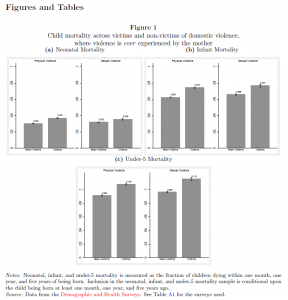Study Counts Devastating Toll of Domestic Violence Faced by Mothers on Their Children

Michelle Kilfoyle and Zahra Siddique – 18 October 2021
Described as the ‘Shadow Pandemic’ by the UN, the global rise in domestic violence against women since the onset of the Covid-19 pandemic is a huge cause for concern. New research further emphasises the urgent need to tackle domestic violence by exposing the scale of its devastating effects on the children of women who suffer at the hands of their partners. The large-scale study, which draws on data from half a million families across the developing world, finds that children born to victims of domestic violence are more likely to die by the age of five than children of mothers who do not. Further, women who experience violence endure more stillbirths.
Even before the pandemic, 1 in 3 women across the world experienced physical or sexual violence mostly by an intimate partner, with rates particularly high in developing regions such as Central sub-Saharan Africa (65.64% of women) and South Asia (41.73%). In 2020, the UN estimated that global cases rose by 20% during lockdown.
This study provides further evidence on the costs of domestic violence by highlighting the damage inflicted upon the wider family, specifically children. Zahra Siddique of the University of Bristol’s Centre for Evidence-based Public Services (CEPS) in the School of Economics, in collaboration with Samantha Rawlings of the University of Reading, analysed the results of 54 Demographic and Health Surveys (DHS) carried out in 32 developing countries between 2000 and 2016.
Collectively, these surveys interviewed around 500,000 women aged 18 to 49 on issues including domestic abuse, births and deaths of children, and pregnancy loss. Interviewers used robust protocols to help participants feel safe and comfortable and maximise the honesty of responses. Twenty-nine per cent of the women reported experiencing physical abuse at some point in their life , while 9% reported experiencing sexual violence.
A host of factors lead to higher death rates among children of mothers who have experienced domestic abuse. In developing countries, families with abusive members tend also to be poorer and less well-educated; all these factors heighten the risk of children dying.
However, Siddique and Rawlings’ research methods allowed them to disentangle the effects of these factors to put precise figures on the damage inflicted by domestic violence alone.
Death rates within the first 30 days of life for children whose mothers experienced physical abuse were 3.7%, compared with 3.0% for children of non-victims. Siddique and Rawlings attribute a significant fraction of this difference – 0.4 percentage points – to the physical abuse. This accounts for around 4,500 deaths among the 1.14 million babies included in this part of the study.
Further, children of domestic-violence victims were 0.7 percentage points more likely to die within a year, and 1.0 percentage points more likely to die within five years of being born. This means that domestic violence led to the deaths of 7,600 babies (of 1.09 million studied) before the age of one, and 8,500 deaths (of 0.86 million children studied) by the age of five.

Most deaths occurred in families where the women experience frequent violence, as opposed to occasional violence.
Further, mothers who experience physical domestic violence were 1.4% points more likely to suffer stillbirth than women who are not victims, with a similar picture emerging for sexual violence.
To help pinpoint the impact of domestic violence on mortality rates, the researchers estimated the influence of ‘unobservables’, that is, differences in characteristics between victims and non-victims that cannot be measured in the data, but can affect mortality rates. They found that the effect of these factors would need to be much larger, by 2-3 times, to be able to completely rule out domestic violence as the cause of the deaths – giving confidence that violence did explain the higher death rates. These behaviours are likely to arise from extreme stress levels, and the study recommends deeper investigation into these factors to better understand the links between domestic violence and childhood mortality.
Michelle Kilfoyle – CEPS Blog Science Writer
Zahra Siddique – Associate Professor of Economics, University of Bristol

